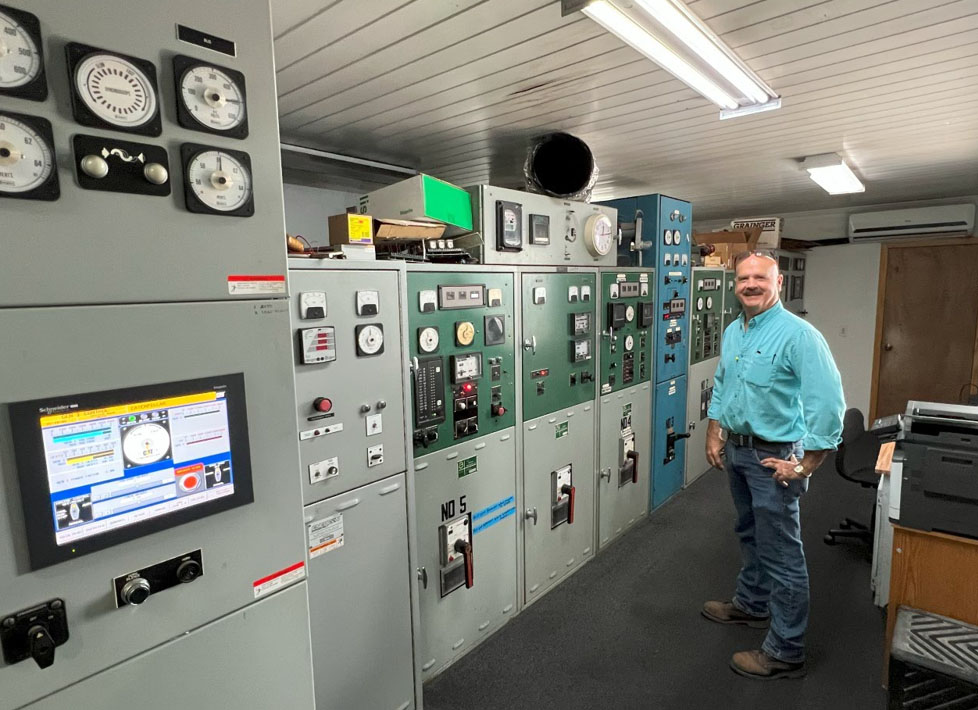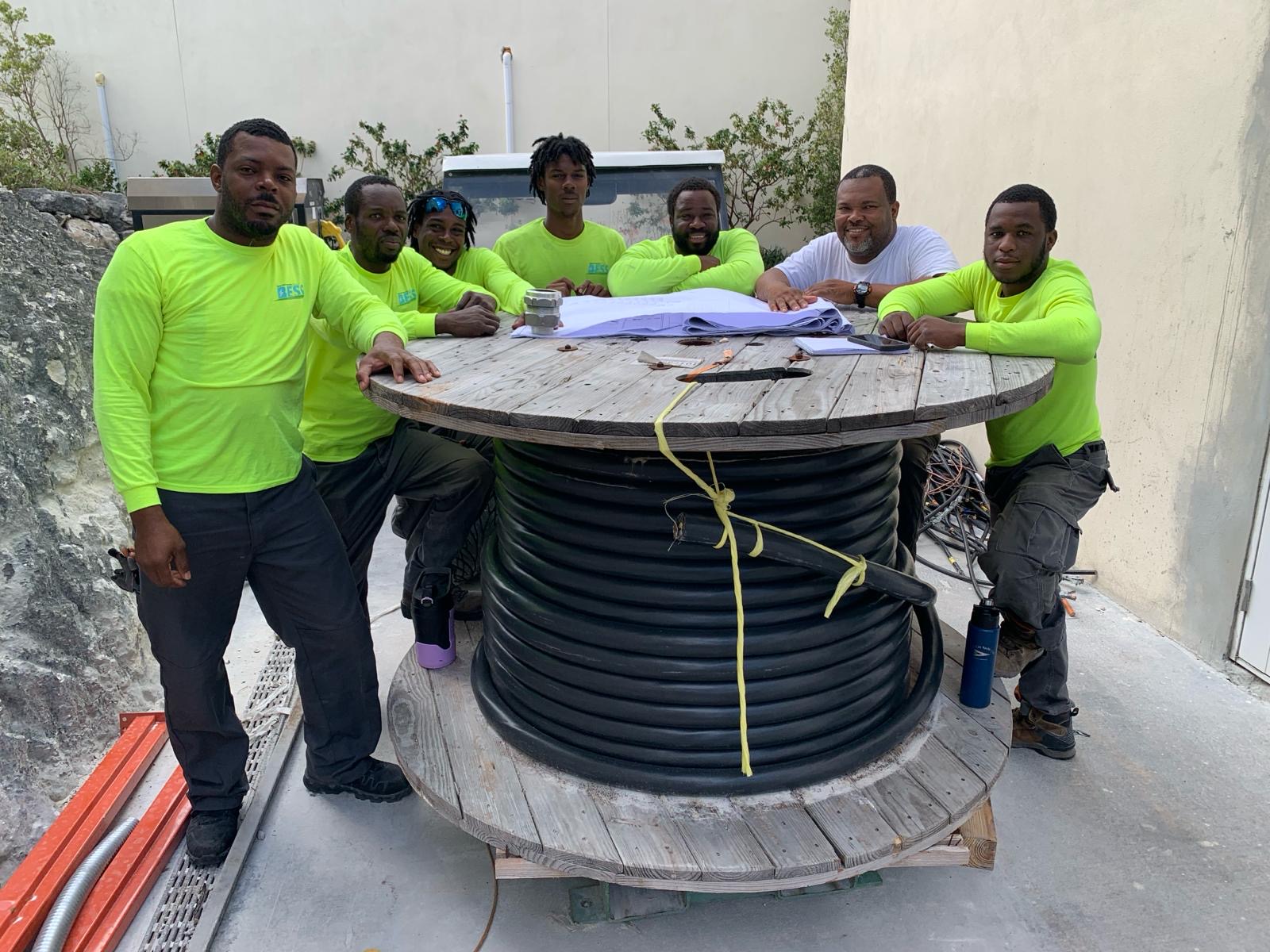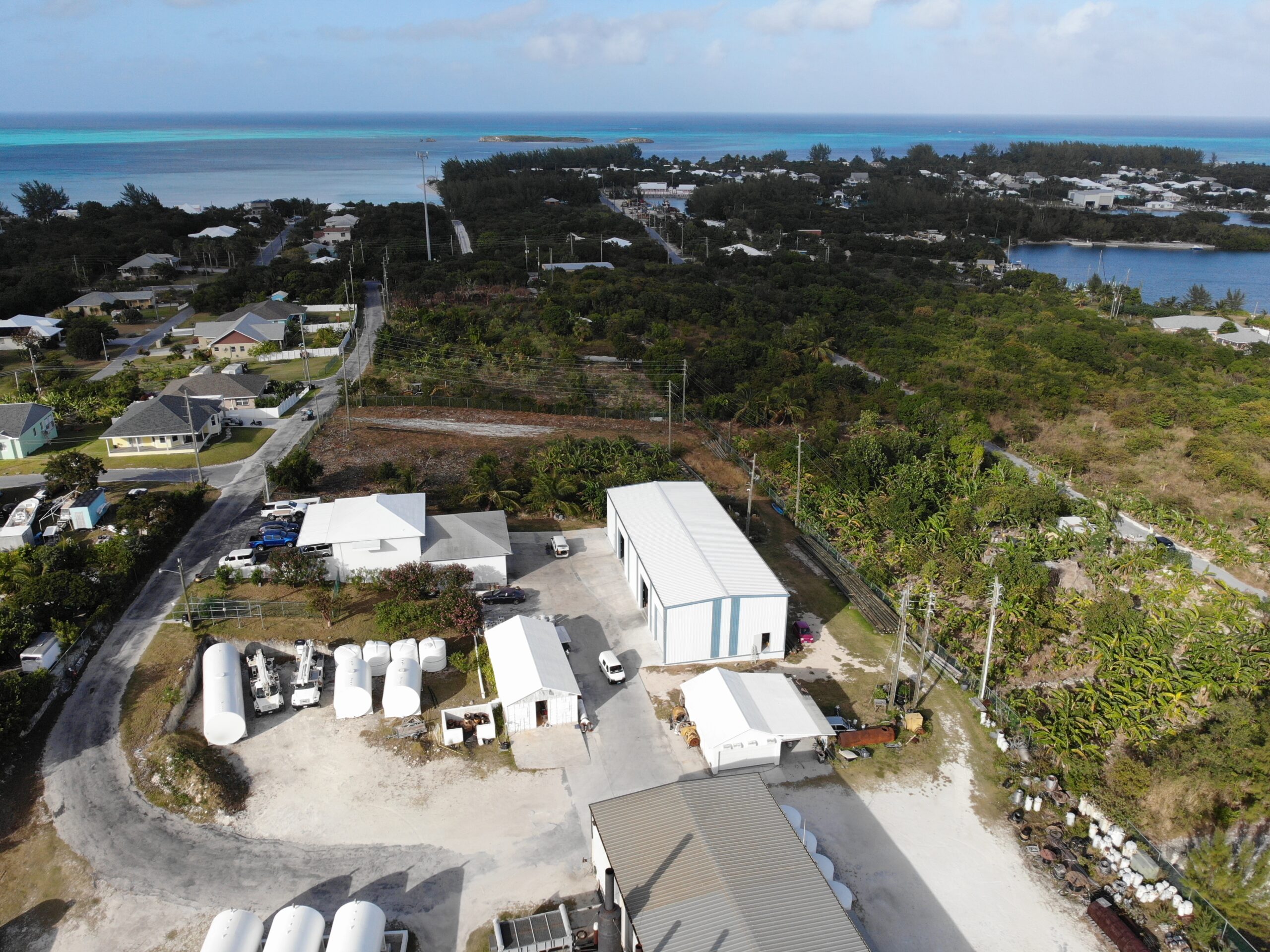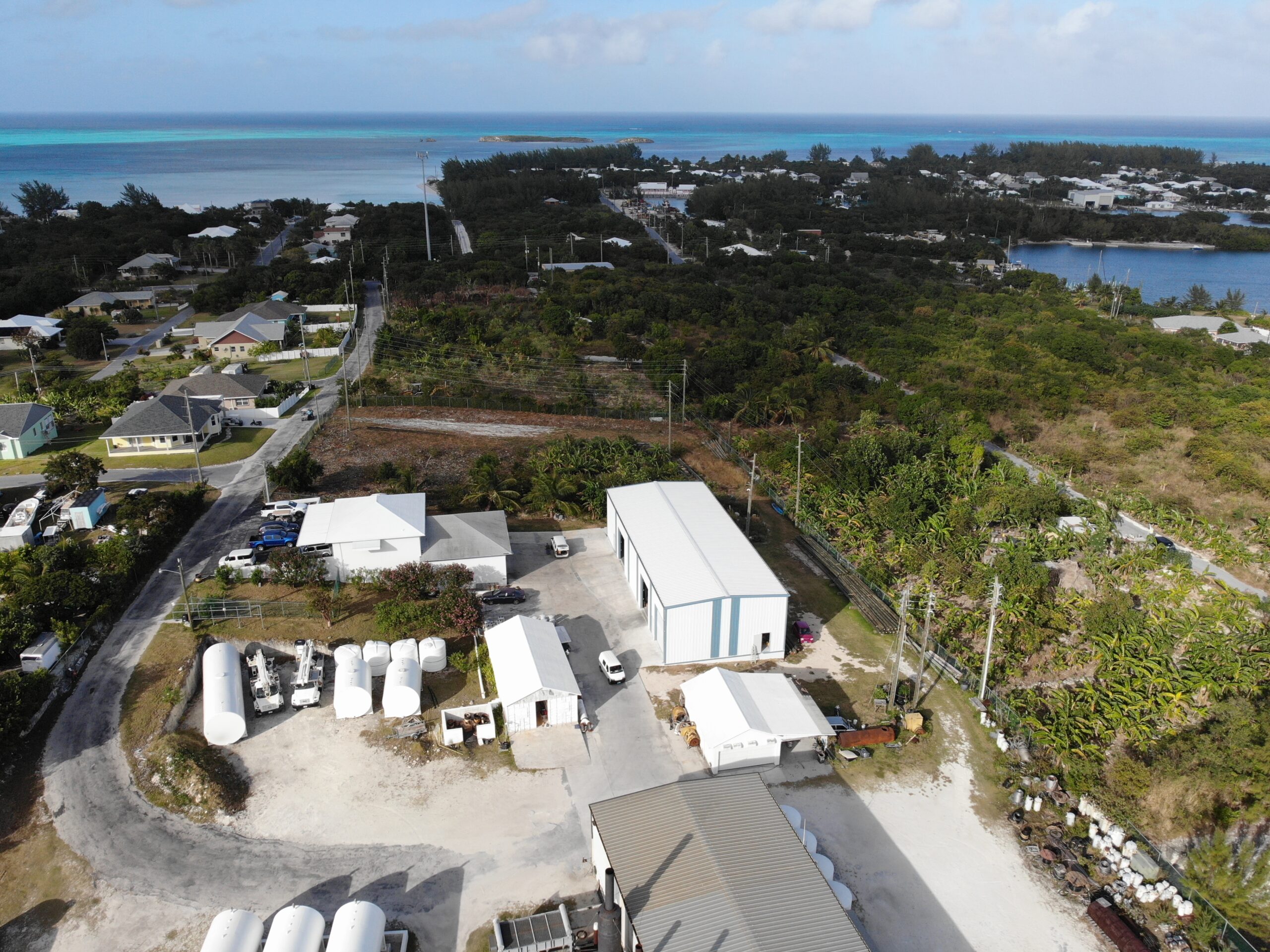WELCOME TO
ST. GEORGE’S CAY POWER COMPANY

Since 1982, our mission is to provide safe, reliable, and affordable electricity to support our 1,500 local families and businesses.
St. Georges Cay Power Company (SGCPC) serves Customers on St. George’s Cay (Spanish Wells), Russell Island, West End Cay, Charles Cay, and Royal Island.
SGCPC is locally owned, and those Shareholders, along with the Officers and Employees are our Neighbors in our Community.


About US
SGCPC is an Authorized Public Electricity Supplier (APESL-18-0003) operating under a 20-year license granted on 1 December 2018, pursuant to the Bahamas’ Electricity Act of 2015.
SGCPC maintains the generation and distribution systems in the Service Area. This includes the powerplant on Russell Island, the two medium-voltage transmission networks, the transformers and distribution wiring, submarine cabling, and Customer meters and premise interconnections.
Our Customers enjoy exceptional reliability because of our construction, maintenance, and operational standards and controls. The last unplanned SGCPC power outage was Nov 2022, previously was in 2021.
The reason for our reliability and quality of service lies in the maintenance and attention to detail by SGCPC Staff regarding the generators, the powerplant, and the island-wide distribution network. Our Customers rely on us to maintain this level of excellence, safety, and reliability.
Outages in other geographical regions of the Bahamas are far more frequent averaging as high as one outage per week or sometimes as frequently as 1-2 times a day.
Today, SGCPC faces the same challenges facing utility companies and communities around the world:
- Keeping electricity prices affordable while still maintaining financial stability for the utility company.
- Rising costs, unreliable supply, and inconsistent cost of petroleum fuels (fossil fuels).
- The threat of damage to our coastal environment and fisheries resulting from fuel spills and air and water pollution.
- Customers have the capability to generate electricity themselves using solar-energy systems.
Implementing renewable energy systems, specifically solar energy, will help us with all three of these challenges.
But how do we manage this growth safely, retain our outstanding reliability track record, remain financially responsible, and keep the prices under control for our Customers that cannot afford to install their own solar powerplant?
At the direction of the Bahamas Utility Regulatory and Competition Authority (URCA), SGCPC is establishing the program, policies, and procedures necessary to manage the growth of solar energy in our service area. This is the same process as followed by Bahamas Power and Light (BPL). Written application and approval from SGCPC are REQUIRED before any Customer can install or operate a solar energy or battery system in our Service Area. This is the exact same requirement as with BPL on New Providence or any of the Family Islands.
URCA is the Bahamas’ independent regulatory authority with responsibility for and authority over all entities that generate, transmit, distribute, or supply electricity to, from, or within The Bahamas. URCA also is required to abide by the Electricity Act of 2024. (EA 2024).
You can find more information here about the SGCPC Solar Community Program or installing solar energy on your property here
WELCOME TO
ST. GEORGE’S CAY POWER COMPANY
We are excited to include you as an SGCPC Customer. Please print this form and bring it to our office for processing. Please also bring your Credit Card or a bank check for billing verification.
We encourage all new customers to read our Renewable Energy Plan (REP). Compliance with the REP and associated URCA-approved policies will be required by any Customer installing their own solar-energy or energy-storage system.
We encourage Customers to call us first, before signing contracts or paying deposits for Customer-owned systems. This will help ensure that you are an informed buyer. A solar-energy system may be a large and complex purchase, and should be researched as carefully as one would research a kitchen or bathroom remodel or swimming pool project.
SOLAR COMMUNITY
Welcome to our solar future!
SGCPC has a plan to move our community toward a more sustainable future using solar energy. This includes a majority of the solar electricity generated by SGCPC-owned systems plus small systems that may be owned and operated by Customers on their own premises. The solar systems owned by SGCPC will be a strategic growth plan designed to maintain reliability and stability while delivering the best financial performance for ALL Customers.
Utilities Regulation and Competition Authority (URCA) is responsible for approval of our formal Renewable Energy Plan (REP). SGCPC will update this Plan annually and submit the updated REP to URCA on an advisory basis. Every three years, URCA is required to conduct a formal review of the Plan.
You can read the Renewable Energy Plan (REP) here.
The Bahamas Energy Act of 2024 (EA 2024) mandates the following.
- Encouragement of competition in the generation of renewable electricity.
- Plans that favor and promote the use of renewable energy “in the absence of competing reliability or cost considerations”.
URCA is therefore obligated to ensure that entities with licenses from URCA incorporate renewable energy in their generation portfolio and allow Customers to install their own renewable-energy systems – provided that those systems do not compromise the safety of the Licensee’s system or network AND are approved by SGCPC.
This EA 2024 mandate requires SGCPC (and other utility license holders) to employ the least-cost options, or options that do not represent an additional financial burden on SGCPC or Customers.
Customer-owned systems are less cost effective overall because they do not get the economy of scale that is inherent in larger purchases of equipment and installation services. That means the electricity from small systems is more expensive than the electricity from larger systems. That is contrary to the EA 2024 which requires lowest-cost electricity.
These reasons are why we favor the Solar Community program. Solar Community will make more solar electricity at a lower cost than Customers building their own small systems

What is Solar Community?
SGCPC is moving forward with building a solar farm next to the powerplant on Russell Island. This solar farm is PHASE 1 of our Solar Community Program. Phase 1 also may include a battery plant, or an Energy Storage System (ESS).
The Phase-1 Solar Farm will be completed in 2024.
PHASE 2 of Solar Community includes the installation of SGCPC-owned solar energy systems on the roofs of Customers’ buildings that are connected to our grid. Land is limited for building more solar farms and land costs are high on Spanish Wells and Russell Island. Because of this land shortfall, SGCPC intends to install and operate PV systems on the roofs of commercial (and possibly also residential) buildings.
The Phase-2 installations will also begin in 2024.
- SGCPC will engineer and install the solar-energy systems to industry best practices.
- That includes a structural analysis to ensure the building and the solar system can support the loads during a hurricane.
- Engineering by a licensed engineer and installation by a licensed electrician are critical parts of the survivability of these systems.
- Selecting products and installation techniques that are shown through engineering analysis to withstand 180 mph winds and site conditions.
- Designing equipment selection for high salt-mist corrosion to extend life cycle and performance.
- SGCPC will pay an annual lease payment to the building owner.
- The lease rate will be based on the capacity of the system and the expected financial performance of the installation.
- Continue to deliver outstanding reliability and higher financial performance for everyone in our community than other solar-energy options that benefit only the system owner.
- SGCPC will pay all capital investment and operational expenses for the solar-energy systems.
- This includes liability insurance. Insurance is necessary to help protect neighbors from risk particularly during a hurricane.
- The financial performance will be evaluated on the ability to maintain or reduce SGCPC operating expenses and ultimately continue to be able to reduce Customer rates.
PHASE 3 will include more land-based Solar plus ESS installation for energy storage and grid stability.
Solar Community is a major investment in our community by SGCPC that will benefit ALL Customers.
- Reduce the cost of electricity for all SGCPC Customers, and not just those that can afford their own solar-energy plant.
- When a Customer installs their own solar-energy plant to power their home or business, over time that causes the cost of electricity for everyone else to go UP.
- Establish more consistency in the rate of electricity.
- The cost of electricity is directly linked to the cost of diesel fuel. When the fuel price cost goes up, electricity prices go up; when the fuel price goes down, electricity prices go down.
- More “utility-scale” solar energy in the SGCPC grid, owned and managed by SGCPC, will result in less reliance and less fluctuation resulting from changing fuel prices.
- Solar energy at the utility scale reduces the risk of environmental damage from fuel spills and reduces air and noise pollution from the operating generators.
- Solar energy reduces our dependence on foreign oil and keep more of our hard-earned money in our community and in the Bahamas.
- The solar-energy industry creates local jobs and careers.
- Solar Community will help us achieve our goal for the Bahamas to reach 30% of our electricity from renewable sources by 2030.
We look forward to building the future together. Thank you for your support.
Morris Pinder; President and General Manager
CUSTOMER-OWNER SOLAR & BATTERY

Who wouldn’t want their own solar-energy plant to make their own electricity and pay less to the utility company?
There have been many homeowners installing illegal systems on their homes for just that reason. It is illegal to install a solar-energy system without SGCPC and Government approval. It also may be unsafe and putting your neighbors at risk.
- Photovoltaic is abbreviated as “PV” and is used as “PV Module (or “panel”) or PV Inverter.
- Energy Storage System is abbreviated as “ESS” and typically includes batteries for energy storage paired with power electronics and control systems for converting the DC to AC and the AC to DC. Self-contained ESS also include fire protection subsystems.
- A “PV System” is a solar-energy system that is always connected to the grid. The PV System is addressed by the SSRG regulations. The PV System has no batteries. A PV System requires the grid to be operating normally for the PV System to operate. Without the grid provided by SGCPC, a PV System would not turn on and would turn off instantly if the grid failed.
- A “PV Microgrid” is a PV system paired with the ESS. The PV Microgrid is addressed by the RESG regulations. This can be constructed as either a Transfer-Switch or Off-Grid configuration. The loads at a Customer premise may never be connected to both the grid and the PV Microgrid at the same time. Users should refer to the Interconnection Requirements or call SGCPC for further information.
We encourage those system owners to embrace the legal requirements and get those systems permitted and approved by SGCPC. Please note that SGCPC has the right and responsibility to deny applications if the capacity exceeds the allowable limits in the REP.
Customers wanting their own solar-energy systems should refer to the SGCPC Interconnection Requirements document before paying deposits or signing contracts.
Customers exporting energy to the grid from a grid-tied solar-energy system will be compensated for the exported electricity pursuant to the URCA-Approved Renewable Energy Plan (REP). Please refer to the (REP) for further details.
Once fully permitted and approved:
- Customer-owned solar-energy only systems (no batteries), a PV System, may connect and operate with the grid.OR
- Customer-owned systems that include batteries, a PV Microgrid, shall NOT be installed in a way that allows the PV or ESS to be connected in parallel with the grid. This is the same safety precaution as when a Customer owns a backup generator – the generator must always be isolated from the grid. Installation requires a mechanical Automatic or Manual Transfer Switch.
All projects require approval from Ministry of Works and Town Council before construction may begin. These approvals are required before SGCPC will conduct any inspection.
Residential PV Systems smaller than 5 kW-AC power capacity shall be submitted directly to SGCPC for processing.
Larger systems require an application to URCA. All Commercial applicants and all PV Microgrids require URCA written approval before SGCPC will review the application.
For new Customer-owned solar-energy systems – the forms necessary for Customer-owned systems are available at our offices during business hours or here.
RENEWABLE ENERGY PLAN (REP) (PROGRAM DOCUMENTS SUBMITTED FOR URCA REVIEW)
INTERCONNECTION REQUIREMENTS (PROGRAM DOCUMENTS SUBMITTED FOR URCA REVIEW)
INTERCONNECTION APPLICATION (PROGRAM DOCUMENTS SUBMITTED FOR URCA REVIEW)
RENEWABLE ENERGY FEE STRUCTURE ADDENDUM (PROGRAM DOCUMENTS SUBMITTED FOR URCA REVIEW)
GLOSSARY & DEFINITIONS (PROGRAM DOCUMENTS SUBMITTED FOR URCA REVIEW)
Application to SGCPC and approval by SGCPC are legally required before operating a customer-owned solar or battery system. Please stop by and chat with us about your plans to make sure it is legal and complies with the Government-approved regulations.
Owners of unpermitted, uninspected, and unauthorized solar energy or battery systems will be notified in writing as directed by URCA to enforce the Renewable Energy Plan (REP). To maintain safety and reliability, those Customers violating the regulations or refusing to follow installation requirements will be disconnected from the grid by removal of their meter and lock out of their grid connection.
OFF-GRID PV MICROGRIDS: It is important for all community members to know that when an Off-Grid PV Microgrid runs out of energy in its battery and the sun isn’t shining, that resident owner will have to run their onsite generator to make electricity. We encourage residents that are considering an Off-Grid PV Microgrid to discuss this situation with their neighbors because of the noise and air pollution that will result from long generator run times.
